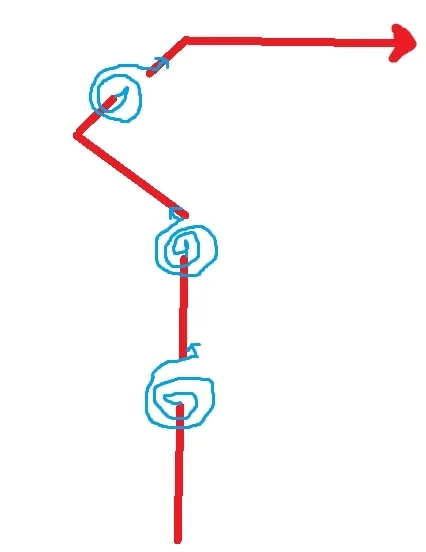Off season tracking training Part 2. Helpful tracking patterns.
I want to close this series with some tracking plans that I find useful to teach specific skills to my dogs. Most of these are used to encourage effective patterns for moving past difficult spots in a live track.
1. Creating dead spaces.
Here is an example of a line where "dead spaces" are intentionally interspersed into the training line. To create the dead space, hoof shoes (or are removed, and no blood is dripped on the ground. Just like when placing a distraction, make sure to mark the exact beginning and end of each dead space clearly. Wearing clean rubber boots is helpful in limiting human scent. The goal is to leave nothing discernible for the dog to follow in the dead zone. In the beginning, I make each space about 20 meters in length, and like to extend them out to 30-50 meters as training progresses. As usual, you should be aging all tracks at least 8-12 hours by the time you reach this stage in training.
The key is in how the dog works through the dead spaces. By this point in training, the dog should be checking back to the point of loss with some degree of regularity when the trail is lost. Within a few yards of the dead space, the dog should return to the last scent. At that point, you can help encourage your dog to search in a widening circular pattern until the trail is intersected. This generally requires directing your dog with encouraging "search here" type commands and using the lead to help direct the dog's search pattern. The more repetition your dog has in working through this same sort of pattern, the more natural it will become. Expect to have to lead your dog to some degree for several attempts. Here is an example of what the search pattern should look like.
2. Creating backtracks.
A backtrack is simple a trail where the deer changes directions and moves down a trail which it had already walked upon. These trails may be directly on top of one another or more commonly, in very close proximity. I have encountered this most commonly in deer that had been bedded for a period of time, and gotten back up. I have also experienced this with deer that received less lethal hits, such as leg wounds and are aware that they are being pursued.
The premise of the track is easy. Lay the initial track (indicated in red), then walk back down a short piece of the track and then leave the trail at an angle (indicated in blue). Some dogs will detect the detoured trail and by luck of the draw make the turn before completing the original length of trail. This is fine, but I try to prevent this by "leading" the dog down the original trail by laying down more blood along this portion. I then make my backtrack portion with hoof scent only for the first several meters into the turn. I like to keep backtracks short because I am trying to train the dog to go back to the point of loss and work out the trail rather than needing to work through a "dead space" type scenario, though that would be effective as well. Here is an example of a linear backtrack and a "narrow angle" backtrack within the same training line.
3. Star pattern...and variations.
The most difficult tracking patterns involve many turns and crossing trails, which creates a maze that many dogs will become stuck in without being able to find the exit trail. A dog with a good circular search pattern may be able to work its way through these patterns without even following the trail perfectly in its entirety. However, a dog with a strong line sense, will work through the crosses in a systematic fashion. Here is the basic star. Crossing trails are indicated in blue.
The key to making this pattern work is the same as with other backtracks. Use more blood on the main trail and just hoof scent on the cross trail. Also make your angles far enough apart from one another that your dog is less likely to wind scent the alternate trail. I find most of my stars are about 50 meters or more in size. Some dogs will still short cut one or more of the corners, but that is not a problem. As long as they work through it, continue on the trail. Unlike most training lessons, I only put a single start variation in any one track.
An alternative to the star that is a bit easier to work through is the figure four. The concept is the same, the pattern is just a bit easier to work through. I also find it useful for dogs that consistently cut the corners of a star pattern. Here is the pattern...pretty straight forward.
For dogs that consistently cut the corners on both the star and the figure four tracks, I find it useful to implement a zig zag pattern. This is easier for the dog to work through, but also requires the same attention to maintain the line. It also prevents the dog from taking a short cut as long as the zigs and zags are a sufficient distance apart. Here is an example.
I
Implementing these tracking patterns into your training sessions will add some variety to you lessons as well as help develop concentration and effective search techniques with your dog. Don't expect your dog to ace all of these skills overnight. These are skills which you will continue to develop over the course of many seasons.
Good hunting! Brady





